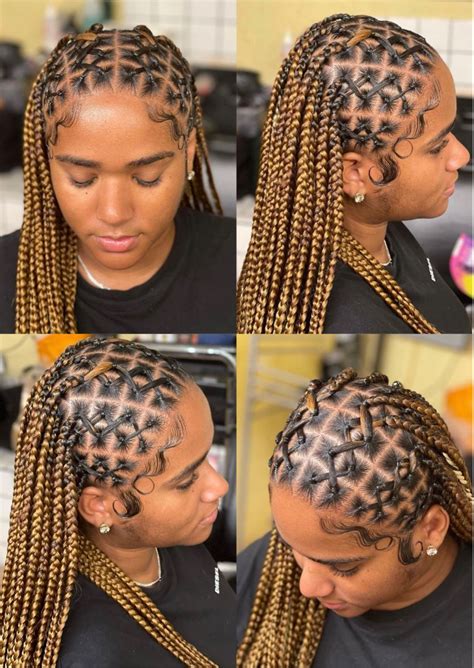Introduction
With the endless array of braiding techniques available, choosing the perfect style can be overwhelming. Two popular options that stand out are micro braids and box braids. Each style offers unique advantages and considerations. In this comprehensive article, we delve into the world of micro braids vs. box braids, exploring their key features, benefits, and drawbacks to help you make the most informed decision for your next hair adventure.

Micro Braids: A Delicate Masterpiece
Micro braids, also known as invisible braids or single braids, are ultra-fine braids that create a polished and intricate look.
Key Features:
- Width: 0.5-1 millimeter (mm) in width, making them nearly invisible to the naked eye.
- Number of Braids: Typically 150-300 braids, resulting in a dense coverage that provides extra protection for the hair.
- Length: Can be tailored to your desired length, ranging from a few inches to several feet.
Benefits:
- Natural Look: Micro braids blend seamlessly with your natural hair, giving you a subtle and elegant style.
- Scalp Health: The fine braiding technique allows for proper scalp ventilation, preventing buildup and promoting hair growth.
- Versatility: Micro braids can be styled in various ways, including buns, ponytails, and updos, making them suitable for any occasion.
- Low Maintenance: While micro braids require regular care, they are generally easier to maintain than larger braids.
Drawbacks:
- Time-Consuming: Installing micro braids can be a lengthy process, taking several hours or even days, depending on the number of braids desired.
- Costly: The labor-intensive installation process often results in higher costs compared to other braiding techniques.
- Tension: If micro braids are not installed properly or become too tight, they can cause tension on the hair follicles, potentially leading to hair loss.
Box Braids: A Bold and Protective Style
Box braids are larger, square-shaped braids that have been popular for centuries.
Key Features:
- Width: 0.5-2 centimeters (cm) in width, giving them a more defined and chunky appearance.
- Number of Braids: Typically 50-100 braids, creating a thicker and bulkier style.
- Length: Can vary greatly, ranging from shoulder length to waist length or even longer.
Benefits:
- Protectiveness: Box braids effectively conceal and protect the natural hair from damage caused by heat, styling products, and environmental factors.
- Durability: They can last for several weeks or even months with proper care and maintenance.
- Statement Style: Box braids are a bold and attention-grabbing choice that can enhance any look.
- Flexibility: Box braids can be customized in terms of size, thickness, and color, allowing for endless creative possibilities.
Drawbacks:
- Weight: Larger box braids can be heavy, potentially causing strain on the scalp and neck.
- Scalp Irritation: If box braids are not washed and dried properly, they can lead to scalp irritation and buildup.
- Difficult to Remove: Removing box braids requires professional assistance, as they are typically glued or sealed at the roots.
Comparison: Micro Braids vs. Box Braids
| Feature | Micro Braids | Box Braids |
|---|---|---|
| Width | 0.5-1 mm | 0.5-2 cm |
| Number of Braids | 150-300 | 50-100 |
| Length | Customizable | Customizable |
| Look | Natural and subtle | Bold and statement |
| Protection | Moderate | High |
| Durability | Shorter (2-4 weeks) | Longer (6-8 weeks) |
| Maintenance | Less time-consuming | More time-consuming |
| Versatility | High | Medium |
| Cost | Higher | Lower |
Mistakes to Avoid
- Choosing the Wrong Braiding Technique: Selecting the right braiding technique for your hair type and desired look is crucial. Consult a professional hairstylist to determine the best option for you.
- Tight Braiding: Avoid braiding your hair too tightly, as this can damage the follicles and cause hair breakage.
- Neglecting Scalp Care: Regular scalp washing and conditioning are essential for maintaining healthy, itch-free braids.
- Overuse of Styling Products: Excessive use of styling gels and sprays can weigh down the braids and cause residue buildup.
- Ignoring Hair Growth: As your hair grows, the braids will become loose and may need to be retightened or rebraided to prevent tangling and breakage.
Conclusion
Micro braids and box braids are both stylish and protective braiding techniques that offer unique benefits and considerations. Micro braids provide a natural, versatile, and low-maintenance option, while box braids offer heavy-duty protection, durability, and a bolder statement style. The best choice for you ultimately depends on your hair type, desired look, and lifestyle. By carefully considering the information presented in this article and consulting with a professional hairstylist, you can make an informed decision and embrace the beauty and functionality of micro braids or box braids.
